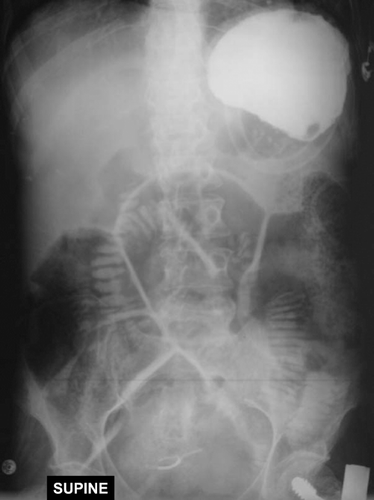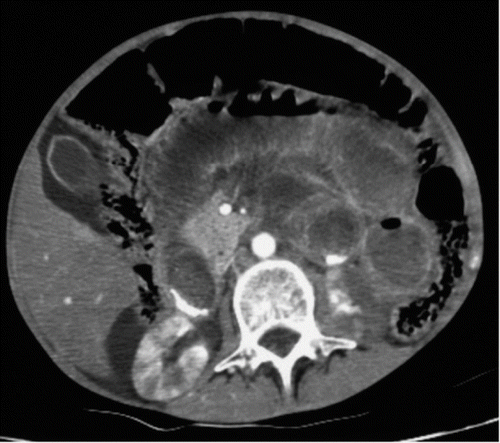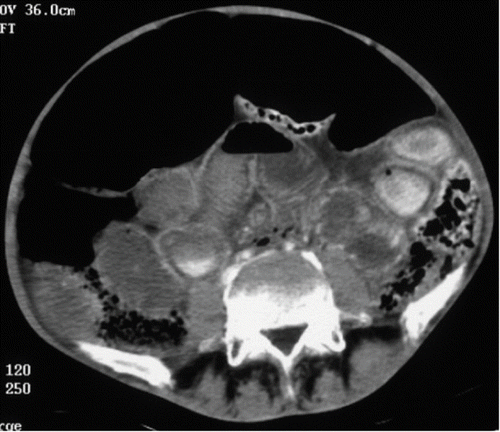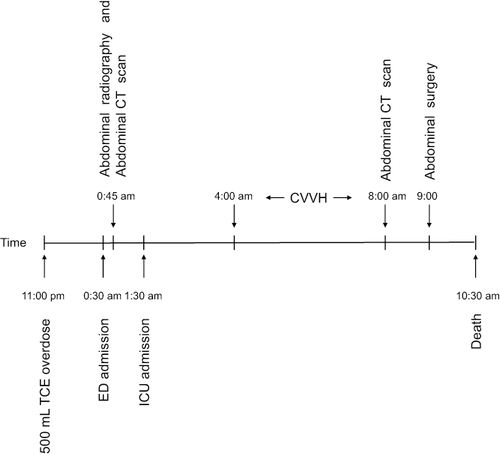Abstract
Introduction. The clinical signs of acute trichlorethylene overdose are commonly coma, cardiac conduction disturbances, diarrhea, and vomiting. We report a case of intentional massive trichlorethylene ingestion inducing a fatal abdominal compartment syndrome (ACS). Case report. A 47-year-old woman was admitted to the emergency department after intentionally ingesting 500 mL of trichlorethylene and benzodiazepines. She rapidly developed coma and abdominal distension leading to multiple organ failure. Subsequent surgical evaluation revealed abdominal perforation and necrosis, and life-sustaining treatments were therefore withdrawn. Discussion. This is a primary ACS that can be explained from experimental data on the pathophysiology of pneumatosis cystoides coli. For this case, we discuss multiple etiological factors for intra-abdominal hypertension (IAP), such as paralytic ileus and massive fluid resuscitation due to the direct toxicity of ingested trichlorethylene. Conclusion. Patients ingesting trichlorethylene need to be closely evaluated for risk of digestive damage and perforation. Early prompt laparotomy must be performed in cases of ACS.
Introduction
A rapid and uncontrolled increase in the volume of intra-abdominal organs can induce intra-abdominal hypertension (IAP) and lead to multiple organ failure. The association of organ dysfunction with an increased abdominal pressure level over 20 mmHg has been defined as abdominal compartment syndrome (ACS) (Citation1). ACS was initially observed in trauma patients but is now reported in a wide variety of medical and surgical critically ill patients. We report a case of acute trichloroethylene (TCE) intoxication inducing fatal ACS.
Case report
A 47-year-old woman was admitted to the emergency department after self-poisoning with benzodiazepines and 500 mL of TCE. On admission, her breath had a faint chloroform-like smell. She had a Glasgow Coma Scale score of 3 and acute respiratory failure with hypoxia (PaO2 84 mmHg) and hypercapnia (PaCO2 74 mmHg). Endotracheal intubation was performed and she was placed under mechanical ventilation.
Her weight was 33 kg, her height was 149 cm, and was suffering from cachexia due to severe anorexia nervosa. She presented with abdominal dilatation as a result of colonic distension as shown by the abdominal X-ray in the supine position () and by the abdominal CT scan (). She was transferred to the intensive care unit (ICU) with severe shock despite fluid expansion and epinephrine infusion, disseminated intra-vascular coagulation, oliguric acute renal failure with profound lactic acidosis, and hyperkalemia: pH 7.12, serum lactate 7 mmol/L (reference range 1.0–0.5 mmol/L), and serum potassium 6.7 mmol/L. Continuous venovenous hemofiltration was started (ultrafiltration rate = 6 L/h). We observed an increase in the abdominal perimeter to 75 cm associated with collateral venous circulation, and grade IV acute IAP was diagnosed on the basis of 28 mmHg urinary bladder pressure measured according to Cheatham's method (Citation1–3). Abdominal perfusion pressure was 20 mmHg (mean arterial pressure of 48 mmHg minus intra-abdominal pressure of 28 mmHg), with a zero value of the filtration gradient according to the consensus criteria of the World Society of the Abdominal Compartment Syndrome (Citation1,Citation2). The worsening of multiple organ failure prompted surgical decompression, immediately after a second abdominal CT scan showing abdominal perforation (). Emergency laparotomy revealed small bowel and right colon diffuse ischemia and life-sustaining treatments were withdrawn. The time interval between ingestion of TCE and death was 12 h ().
Fig. 1. Anteroposterior abdominal radiograph showing laminated edge in small bowel and colic distension. The film shows opacification from trichlorethylene remaining in the stomach since trichlorethylene is radiopaque.

Fig. 2. Early axial computed tomography scan of the upper abdomen with contrast showing colic dilatation, right cortical ischemic hyperdense kidney, and liver ischemia.

Fig. 3. Late axial abdominal computed tomography scan showing pneumatosis intestinalis, intra-peritoneal effusion, and pneumoperitoneum.

Fig. 4. Time intervals between poisoning and death. CVVH, continuous venovenous hemofiltration; CT, Computed Tomography; ED, emergency department; ICU, intensive care medicine; TCE, trichloethylene.

The diagnosis of TCE poisoning was retrospectively confirmed by gas chromatography with mass spectrophotometric analysis: TCE and trichloracetic acid gastric fluid levels were 32 and 1.8 mg/L, respectively, and blood levels 1.4 and 3 mg/L.
Discussion
To our knowledge, this is the first documented report of ACS because of TCE ingestion. Clinical effects of acute TCE poisoning are coma, cardiac conduction disturbances, ventricular arrhythmia, diarrhea, and vomiting. In our patient, coma developed shortly after poisoning probably because of the simultaneous ingestion of benzodiazepine and a very high dose of TCE. Our case contrasts with the previously published acute TCE overdose observations by the severity of the digestive symptoms. The very high dose of TCE ingested was probably responsible for the fatal outcome (Citation4,Citation5).
ACS was diagnosed on the basis of an increase in the abdominal perimeter (Citation6), after determination of IAP (Citation1,Citation2). IAP is defined by IAP ≥ 12 mmHg, whereas ACS is defined by IAP ≥ 20 mmHg with at least one organ failure (Citation1,Citation2,Citation7–9). In our patient, the diagnosis of ACS was established by sustained IAP ≥ 20 mmHg and abdominal perfusion pressure < 60 mmHg associated with multiple organ dysfunction (Citation1,Citation2). An increase in IAP ≥ 15 mmHg is associated with respiratory failure accompanied by hypercapnia and hypoxemia. An increase in IAP ≥ 20 mmHg is associated with a marked reduction in cardiac output and oliguria. In a recent study, a mortality rate of up to 64% was reported in patients with urinary bladder pressure over 25 mmHg (grade III) and organ dysfunction, when ACS was due to the presence of intra-abdominal or retroperitoneal pathology (Citation10).
The connection between TCE ingestion and ACS remains speculative but could be inferred from experimental data on the pathophysiology of pneumatosis cystoides coli (Citation11). TCE exposure is known to limit the metabolism of hydrogen-consuming colonic bacteria, which leads to a massive increase in hydrogen tension in the gut lumen and thereby to acute gut distension. In addition, colonic bacteria that consume hydrogen form methane gas in the process. As the abdominal cavity is not expandable, the increase in gut volume results in an increase in abdominal pressure, which was all the more acute in our patient as she had severe anorexia nervosa and very low body mass index. The sustained high intra-abdominal pressure impaired splanchnic blood flow and capillary perfusion and induced multiorgan failure dysfunction.
Conclusion
Physicians should be aware that acute TCE may induce severe primary ACS as the result of massive bowel distension. Prompt decompression surgery by laparotomy should be performed in these patients.
References
- ML Malbrain, ML Cheatham, A Kirkpatrick, M Sugrue, M Parr, J De Waele, Z Balogh, A Leppäniemi, C Olvera, R Ivatury, S D'Amours, J Wendon, K Hillman, K Johansson, K Kolkman, and A Wilmer. Results from the international conference of experts on intra-abdominal hypertension and abdominal compartment syndrome. I. Definitions. Intensive Care Med 2006; 32:1722–1732.
- G An, and MA West. Abdominal compartment syndrome: a concise clinical review. Crit Care Med 2008; 36:1304–1310.
- ML Cheatham, and K Safcsak. Intraabdominal pressure: a revised method for measurement. J Am Coll Surg 1998; 186:594–595.
- P Auzépy, C Verger, and M Deparis. Actualité de l'intoxication aiguë par le trichloréthylène chez l'adulte à propos de 17 cas. Ann Med Int 1976; 11:817–822.
- G Gindre, S Le Gall, P Condat, and JE Bazin. Fibrillation ventriculaire tardive au décours d'une intoxication au trichloréthylène. Ann Fr Anesth Reanim 1997; 16:202–203.
- A Kirkpatrick, F Brenneman, R Mc Lean, T Rapanos, and B Boulanger. Is clinical examination an accurate indicator of raised intra-abdominal pressure in critically injured patients?. Can J Surg 2000; 43:207–211.
- ML Malbrain, D Chiumello, P Pelosi, D Bihari, R Innes, M Ranieri, M Del Turco, and A Wilmer. Incidence and prognosis of intraabdominal hypertension in a mixed population of critically ill patients: a multiple-center epidemiological study. Crit Care Med 2005; 33:315–322.
- M Malbrain, D Chiumello, A Wilmer, N Brienza, V Malcangi, D Bihari, and R Innes. Prevalence of intra-abdominal hypertension in critically ill patients: a multicentre epidemiological study. Intensive Care Med 2004; 30:822–829.
- CD Raeburn, EE Moore, WL Biffl, JL Johnson, DR Meldrum, PJ Offner, RJ Franciose, and JM Burch. The abdominal compartment syndrome is a morbid complication of postinjury damage control surgery. Am J Surg 2001; 182:542–546.
- Z Balogh, BA McKinley, JB Holcomb, CC Miller, CS Cocanour, RA Kozar, A Valdivia, DN Ware, and FA Moore. Both primary and secondary abdominal compartment syndrome can be predicted early and are harbingers of multiple organ failure. J Trauma 2003; 54:848–859.
- TH Florin. Alkyl halides, super hydrogen production and the pathogenesis of pneumatosis cystoides coli. Gut 1997; 41:778–784.
